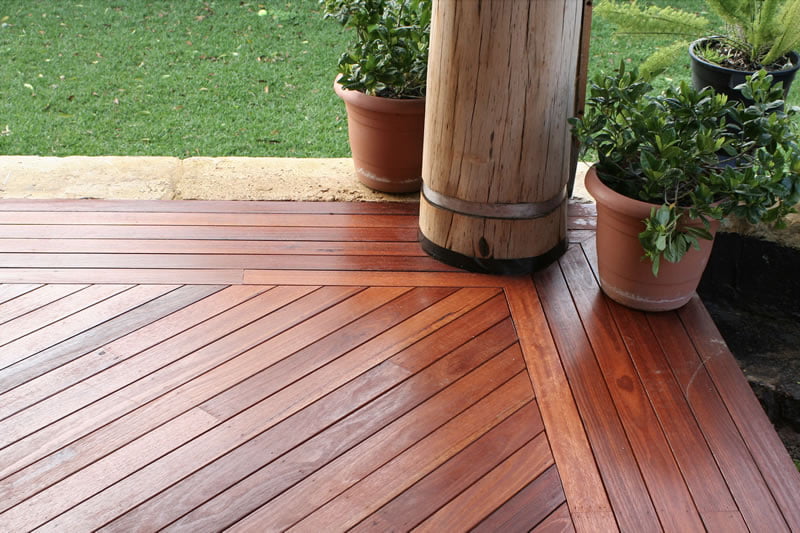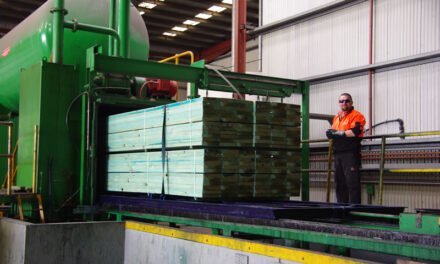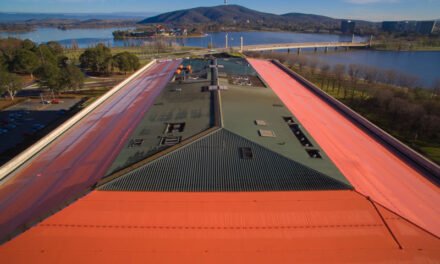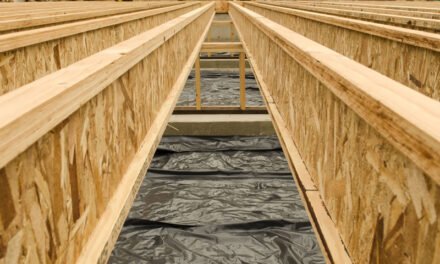Pre-coating timbers – whether internal or external – doesn’t just save builders time, it delivers better, longer lasting results and can even solve some common installation problems.
Timber suppliers and builders coexist in mutually beneficial relationships for the most part, but it’s not always a perfect harmony. Disputes over who is responsible for rectifications aren’t uncommon, and the poor timber merchant can find themselves in the middle of a multi-part argument, with the builder blaming (in this case) the timber supplier for a poor result, the timber supplier claiming it was a bad choice of coating and the coatings supplier saying the problem lay with a flawed application.
“In the past, there was a disconnect between the paint companies and the timber suppliers,” says Glen Quince, state manager NSW for Simmonds Lumber.
He says that until a few years ago, paint and oil companies would come up with products based on consumer desires without collaborating with timber suppliers, while timber suppliers would tell customers that their products needed coating, but not sit with the coatings companies to learn which options to recommend in which situations.
“We never actually worked with each other to find out what works best on which products,” Quince says. “In the last five or so years, there’s been more of a connection between timber producers and the paint companies working with each other.”
Major mills including Pentarch (formerly Boral) and Parkside have formed strong connections to coatings suppliers with each helping the other to develop their offer in a way that’s mutually beneficial and takes into account how the products are actually used.
“The end user wants something that works well and doesn’t alter the timber in ways they don’t want or encourage other problems later,” says Quince.
“The best solution is to deliver a product that’s as foolproof as possible, so the builder can get the job up and get paid as quickly as possible and the owner can have a result that lasts as long as possible. Pre-coating, whether that’s pre-oiling external timbers or pre-priming internal ones, goes a long way to delivering that.”
Oils that last
Several of the major timber suppliers that specialise in hardwoods, like Simmonds Lumber and Kennedy’s Timbers, now offer pre-oiled product to the market.
“It’s a recent shift for us,” says Quince. “We’re really aligned with hardwood products, be that merbau, imported hardwoods or Australian hardwood products. A couple of our key suppliers are pushing pre-oiled product more towards their market and we can see the benefit of it.”
The timber – usually decking but also screening, pergola and stair posts and sometimes cladding – is run through an oiling machine that covers it in the chosen coating product.
Unlike oiling done on site, it completely covers the timber, including the underside, provides an even distribution of product without missed patches or over-application and it is on the timber much earlier in the lifespan of the product, so it’s protected through shipping, in yards and on site, even when projects are delayed.
“Builders can’t be guaranteed of having skilled labour at every step,” Quince says. “So we take this little bit of time-consuming and fiddly work away from them, and hopefully minimise some issues they might otherwise have on site down the track.”
One of the most common issues has come out of changing trends in house design. With more homes being built directly onto concrete slabs, more decks are being laid very low to the ground, with minimal clearance underneath for ventilation.
“People want to build an al fresco area straight off the back of house and they’ve only got a 100mm or 200mm gap from the ground upwards,” says Quince. “At the same time, the trend has gone from using a narrow decking board to a wider decking board. When you’ve got a deck that’s low to the ground with boards around 150mm wide, you get a lot of issues with swelling up or cupping.”
There’s no point highlighting the Australian Standards that say this is way too close to the ground, as many of these are DIY jobs. “But they want to use the same wide boards they see in magazines and on TV, and they like the fact they need fewer attachments per square metre, so it goes down faster,” Quince says.
“So there’s no ventilation underneath, they often don’t leave wide enough gaps between boards and, if they’re doing their own oiling, they haven’t coated the underside of the boards before they lay the deck, because they don’t know they need to. When the deck blows up, they blame the timber. Part of the benefit we see in pre-coating for people is that, while it doesn’t completely solve the problem of the deck laid on the ground, it may help minimise some of these issues down the track.”
Gap size is a frequent problem with wider boards, notes Quince. “These boards offer an attractive look, and they lay an area of ground much quicker than your old 75mm board,” he says, “so I can see why builders like them. But some people are still laying them with a 3mm gap between boards when you should be going to 5-7mm.
“We were getting a lot of call-outs to jobs, and then having to gently explain to the builder why the job has had a problem. And it’s not a problem with the timber product itself, it’s either not the right product for the job or it hasn’t been installed correctly. So we were having to explain this to builders and try to rectify it, whereas pre-oiling is a way to fix it up and solve a lot of problems before they go bad.”
Simply coating the underside of the boards is enough to stop some moisture-related issues in decks before they cause major problems. “Even for builders who understand the underfloor/board width/gap relationship, this was something where a lot would say ‘look, we weren’t aware we had to do that’,” Quince says. “So by pre-oiling, we’ve done the first part for them and it makes it a lot easier. It won’t solve all their problems, but it will minimise them and reduce the number of call-outs.”
Pre-oiling is also very cost effective. The deck will need oiling regardless; doing the first coat before the timber is sold costs the same as or less than doing it on site and delivers better protection from the start of the board’s life cycle.
It also helps to minimise the amount of tannin that will leach from a new deck, which offers a better degree of protection for nearby paving – a particularly important consideration for timbers like merbau.
Choose your priority
“We offer two different pre-oiling treatments,” says Quince. “A penetrating oil from Cutek and Intergrain’s Universal Timber Oil. They’re both very good products that suit different end users, depending on what they are most concerned with.”
Simmonds also runs two separate oiling machines, one for each type of product, a Ceetec for Intergrain’s Universal Timber Oil (the same oil that Kennedy’s uses in general) and a Titan for the Cutek product.
“We installed the second machine just before Christmas, so we can keep the two streams separate,” Quince says.
“The reason we run two oils is there’s benefits to both. Intergrain is recommended by a lot of the main hardwood producers, like Pentarch and Parkside. It’s an envelope coating: it doesn’t penetrate deep into the timber, but it coats all four sides through the machine quite well.”
Universal Timber Oil has three main benefits. Number one is that it doesn’t alter the characteristics of the timber. The colour, texture and finish are enhanced but not changed as significantly as they will be with many other coatings.
Number two is the big one: it’s an open system, so customers can use any brand or type of oil afterwards for their top coat rather than being restricted to water-based on water-based or oil on oil.
Finally, because it’s water-based, the drying time is short and the clean-up is easy.
“When we go to Cutek,” says Quince, “it operates slightly differently. Cutek actually absorbs into the timber. Personally, I’ve more often used that penetrating product on the timber around my own home, and it also delivers a great result, just without the quick drying time. But I can manage the payoff of a slower job each time because it doesn’t need to be repeated quite as frequently. That’s not for everybody. The downside of the product is once you precoat with Cutek, you’ve got to reuse Cutek on it and continue to use that.
“So both products have their benefits and their downsides. I feel the Intergrain lasts a little less long, because it’s an envelope coating rather than penetrating, but for most users who re-oil their deck once a year, this won’t make any difference and the open system and clean-up trade-off is worth it.”
Simmonds already has a strong customer base for both product lines and the company is very happy to keep the options open. “Both products can be wet-stacked after they’ve gone through the machine,” Quince says. “The boards won’t dry together. The difference is Intergrain dries quickly, while the Cutek will be still a little bit wet three or four days later. Most of what we’ve been pre-coating so far has been decking boards. But we’re also doing posts and F27 as well as screens.”
Both coatings companies also offer tinted/pigmented product for subsequent coats.
“We send out an installation guide with each order,” says Quince. “It tells the customer ‘your product has been coated with this, here’s a guideline for everything that will go with it.’ And both Cutek and Intergrain offer a backup service where they can help guide the customer to make choices about things like colour pigments.”
The pigment options can provide a particular architectural look, help one type of timber look like another, or even add to the durability of the outdoor timber as darker pigments act like sunscreen for the wood.
“Credit to both Cutek and Intergrain, they each have an excellent backup service,” Quince says. “They’re both more than willing to assist people with achieving the look they’re after. The market has been a little bit slow on the uptake when it comes to pre-oiling, but we think within the next couple of years you’ll find that most hardwood products will come through pre-oiled.”
Once installed, give the timber a quick wash to remove any marks, then a second coat with a third for specialty finishes or details, such as architectural screens.
Primed for success
Exterior timbers aren’t the only ones that benefit from pre-coating.
“We do a number of pre-primed products in radiata pine,” says Quince. “That’s your painted white-primed material for architraves skirtings door jambs, things like that. And then in addition to those, we do a range of H3 Primed, which is for your external products. It’s also radiata pine that’s been treated, then the priming is done as a pre-paint for outdoor timbers, like decks, pergolas and things like that.”
The timber merchants who take these lines sell a lot to domestic residential builders and DIYers – as with the pre-oiled timbers, the convenience factor more than outweighs the cost versus unprimed.
“A lot of material that goes into high-rise buildings, apartments and so on, where they’re fitting out all the skirtings, door frames and the like,” Quince says.
“On those jobs, our customers just want a product that is easy to use; they’re not going to get any comebacks on it and their customers aren’t going to be having problems with rectifications.”
Which sounds simple enough, but it took Simmonds a number of years to find the best products for the job. “When we only sold unprimed product, the natural variation in timber meant there would be some areas that were darker or lighter than the rest, and then someone rushing a job would skimp on the priming and we would end up with the client complaining to our retail partner that there were shadowy marks coming through,” says Quince.
The Simmonds team began testing primers, but it wasn’t a simple task.
Quince says, “Because it’s applied before the mouldings and so on are cut to size, it needs to be soft and flexible enough that people can cut it on site without chipping up the ends. Same for nail holes and general wear and tear: every bit of damage needs to be puttied up and sanded back by someone and that adds time and cost to the job.
“We needed a primer that was hard-wearing enough to do the job, but not so brittle it would add to workload on site: the entire idea is making people’s jobs easier!”
After several years of R&D working with their supplier mills, Simmonds settled on effective formulations that have had great success. “For the white primed, which is your internal architraves and so on, a lot of that is coated with a gesso coat, a combination of glues and gypsum,” says Quince. “It gives you a nice coating, but at the same time, if you get it wet, it doesn’t deteriorate or disappear. We find it’s a comfortable medium.”
The one drawback to the product is that it blunts sawblades very quickly because of the gypsum content. “We’ve had to talk with builders and remind them that if they’re cutting a lot of this, they’ve also got to change their blades or sharpen them on a regular basis, so they don’t start chipping out the ends,” Quince says.
He jokes that a lot of product evolution with pre-coatings has been about reflecting the changing nature of building: “It used to be all about the cheapest product, now builders don’t want to spend time rectifying jobs. They just want to be able to do a job know it’s finished, get paid and move on to the next one. It’s really pushed people like us to deliver high quality products into the market that have very minimal potential issues. The builders can go in and put the job up, putty off their holes, basically paint straight over the top and it’s ready to go. It minimises time on site for them.”
Educating the user
The enthusiastic adoption of pre-coated timbers by builders, and the fact that end users can see the overall cost savings and quality improvement, is helping to speed their uptake in the market. The remaining challenge is educating the end user on upkeep.
“One thing I’d say is that, if you’re going to spend the money to put a hardwood deck down, the least you can do is spend maybe an extra $100 on oil,” Quince says. “Instead of buying a bargain brand $80 to $100 tin of oil, maybe spend $150 to $180 on that same-sized tin but go to a better brand. You’ve done all the hard work laying the deck, why not spend a little bit extra on the coating you put on top of that as well? It’s such a small amount in the overall cost, but it gives you a noticeably better result.”
Each coating comes with its own recommended schedule of maintenance, generally re-oil once every year or two for decks and stairs and five to ten years for repainting. Adhering to the recommended schedule won’t just deliver the best look for your project, it will help to protect your timber for the full span of its durability class. Coatings, however, won’t make up for using timbers of inferior durability or treatment class in any application– at least, not for long.
Quince has an insider tip for people worried about ongoing costs. “The paint companies are going to give me grief for this, but rather than paying for deck wash or tannin-stripping products, which are $50 or $60 a pop, I use Napisan,” he says.
“It’s about $8/kilogram and I use about 200g in a bucket of warm or hot water, scrub it in with a good hard bristle broom – don’t get the timber too wet – leave from four up to eight hours then hose off with a Gerni (high pressure cleaner), which leaves the deck clean and dries quickly. It does the exact same job for a fraction of the price.”
Quince also recommends builders spend a little more time talking with their clients about the fact timber is different to some other building products. “People look at concrete, steel and things like that and they’re the same from day one to day 1000,” he says. “They don’t understand that timber products are natural products, they change with the seasons of the year.
“In Sydney, it’s usually dry and hot between September and November and you’ll get gaps in between your decking boards because they’ve dried out. People call and they say ‘I’ve got gaps!’ whether that’s in the deck or their floorboards. Then from January through to March, we get more humid weather and afternoon showers and, because there’s a lot more moisture in the air, those gaps close up because of that humidity and people see why they’re needed.”
Talking with clients about timber add-ons such as pre-coating can be a good lead-in to these sorts of discussions, says Quince: “It reminds them that the things that are good about timber – its warmth, durability and flexibility – are all because of those natural qualities. People understand that natural things need upkeep and that they react to the atmosphere around them and change as the year goes on. If your skin is drying out from your air conditioning or your wood fire, so is your timber.”
For more information, visit www.simmondslumber.com.au, www.intergrain.com.au and www.cutek.com.au, or for reclaimed timbers available pre-oiled, visit www.kennedystimbers.com.au
Image: Pigments can be added to second and third coats for colour changes. Courtesy Simmonds Lumber.












